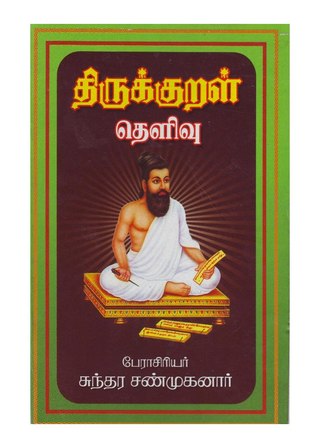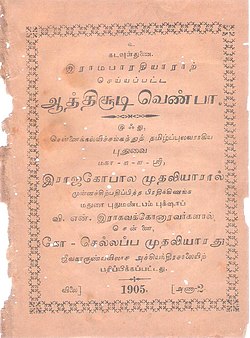In poetry, a couplet is a pair of successive lines that rhyme and have the same metre. A couplet may be formal (closed) or run-on (open). In a formal (closed) couplet, each of the two lines is end-stopped, implying that there is a grammatical pause at the end of a line of verse. In a run-on (open) couplet, the meaning of the first line continues to the second.
A rhyme is a repetition of similar sounds in the final stressed syllables and any following syllables of two or more words. Most often, this kind of perfect rhyming is consciously used for a musical or aesthetic effect in the final position of lines within poems or songs. More broadly, a rhyme may also variously refer to other types of similar sounds near the ends of two or more words. Furthermore, the word rhyme has come to be sometimes used as a shorthand term for any brief poem, such as a nursery rhyme or Balliol rhyme.
Unless otherwise noted, statements in this article refer to Standard Finnish, which is based on the dialect spoken in the former Häme Province in central south Finland. Standard Finnish is used by professional speakers, such as reporters and news presenters on television.
Sandhi is a cover term for a wide variety of sound changes that occur at morpheme or word boundaries. Examples include fusion of sounds across word boundaries and the alteration of one sound depending on nearby sounds or the grammatical function of the adjacent words. Sandhi belongs to morphophonology.
Sona is an international auxiliary language created by Kenneth Searight and described in a book he published in 1935. The word Sona in the language itself means "auxiliary neutral thing". Contrary to popular belief, the similarity to the English word 'sonorous' is superficial.

Sinhala, sometimes called Sinhalese, is an Indo-Aryan language primarily spoken by the Sinhalese people of Sri Lanka, who make up the largest ethnic group on the island, numbering about 16 million. Sinhala is also spoken as the first language by other ethnic groups in Sri Lanka, totalling about 2 million speakers as of 2001. It is written using the Sinhala script, which is a Brahmic script closely related to the Grantha script of South India.

The Tamil script is an abugida script that is used by Tamils and Tamil speakers in India, Sri Lanka, Malaysia, Singapore, Indonesia and elsewhere to write the Tamil language. It is one of the official scripts of the Indian Republic. Certain minority languages such as Saurashtra, Badaga, Irula and Paniya are also written in the Tamil script.

The Kural is one of the most important forms of classical Tamil language poetry. It is a very short poetic form being an independent couplet complete in 2 lines, the first line consisting of 4 words and the second line consisting of 3. As one of the five types of Venpa stanza, it must also conform to the grammar for Venpa, the most difficult and the most highly esteemed of stanzaic structures in classical Tamil literature. The Tirukkuṛaḷ by Tiruvalluvar, one of the greatest philosophical works in Tamil, is a typical example.
Tolkāppiyam, also romanised as Tholkaappiyam, is the most ancient extant Tamil grammar text and the oldest extant long work of Tamil literature. It is the earliest Tamil text mentioning Gods often identified as Hindu deities. Mayyon as (Vishnu), Seyyon as (Skanda), Vendhan as (Indra), Varuna as (Varuna) and Kotṟavai as are the gods mentioned. The surviving manuscripts of the Tolkappiyam consists of three books (atikaram), each with nine chapters (iyal), with a cumulative total of 1,610 (483+463+664) sutras in the nūṛpā meter. It is a comprehensive text on grammar, and includes sutras on orthography, phonology, etymology, morphology, semantics, prosody, sentence structure and the significance of context in language.
The phonology of the Hungarian language is notable for its process of vowel harmony, the frequent occurrence of geminate consonants and the presence of otherwise uncommon palatal stops.
In linguistics, syllable weight is the concept that syllables pattern together according to the number and/or duration of segments in the rime. In classical Indo-European verse, as developed in Greek, Sanskrit, and Latin, distinctions of syllable weight were fundamental to the meter of the line.
In an alphabetic writing system, a silent letter is a letter that, in a particular word, does not correspond to any sound in the word's pronunciation. In linguistics, a silent letter is often symbolised with a null sign U+2205∅EMPTY SET. Null is an unpronounced or unwritten segment. The symbol resembles the Scandinavian letter Ø and other symbols.
Much of Tamil grammar is extensively described in the oldest available grammar book for Tamil, the Tolkāppiyam. Modern Tamil writing is largely based on the 13th century grammar Naṉṉūl, which restated and clarified the rules of the Tolkāppiyam with some modifications.
Modern Literal Taiwanese (MLT), also known as Modern Taiwanese Language (MTL), is an orthography in the Latin alphabet for Taiwanese based on the Taiwanese Modern Spelling System (TMSS). MLT is able to use the ASCII character set to indicate the proper variation of pitch without any subsidiary scripts or diacritic symbols.
Tamil phonology is characterised by the presence of "true-subapical" retroflex consonants and multiple rhotic consonants. Its script does not distinguish between voiced and unvoiced consonants; phonetically, voice is assigned depending on a consonant's position in a word, voiced intervocalically and after nasals except when geminated. Tamil phonology permits few consonant clusters, which can never be word initial.
Tamil prosody defines several metres in six basic elements covering the various aspects of rhythm. Most classical works and many modern works are written in these metres.

The Tirukkuṟaḷ, or shortly theKural, is a classic Tamil language text consisting of 1,330 short couplets, or kurals, of seven words each. The text is divided into three books with aphoristic teachings on virtue (aram), wealth (porul) and love (inbam), respectively. It is widely acknowledged for its universality and secular nature. Its authorship is traditionally attributed to Valluvar, also known in full as Thiruvalluvar. The text has been dated variously from 300 BCE to 5th century CE. The traditional accounts describe it as the last work of the third Sangam, but linguistic analysis suggests a later date of 450 to 500 CE and that it was composed after the Sangam period.
Telugu is an agglutinative language with person, tense, case and number being inflected on the end of nouns and verbs. Its word order is usually subject-object-verb, with the direct object following the indirect object. The grammatical function of the words are marked by suffixes that indicate case and postpositions that follow the oblique stem. It is also head-final and a pro-drop language.
Luchazi is a Bantu language of Angola and Zambia. Luchazi is the principal language of the Ngangela Group. Ngangela is a term coined by the Vimbundu traders and missionaries in 18th century to describe the tribes occupying the area of eastern-central Angola.

Commentaries to literary works remain one of the most important and telling aspects of the Tamil literary tradition. Commentaries to ancient Tamil works have been written since the medieval period and continue to be written in the modern era. Many ancient Tamil works continue to remain in comprehension chiefly due to exegesis or commentaries written on them. The most famous examples of such works are the Tolkappiyam and the Tirukkural, with the latter remaining the most reviewed work in the Tamil literature.







